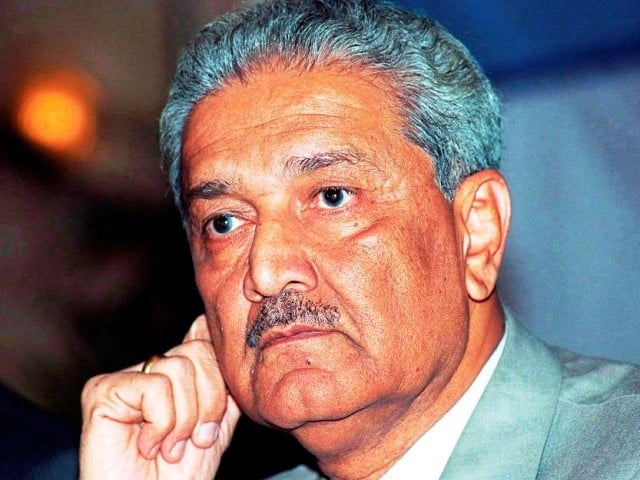 Abdul Qadeer Khan(born 1935 or 1936)
Abdul Qadeer Khan(born 1935 or 1936) Pashto/Urdu: ڈاکٹر عبد القدیر خان; , known as A. Q. Khan, is a Pakistani former nuclear physicist and a metallurgical engineer, who founded the uranium enrichment program for Pakistan's atomic bomb project. Khan founded and established the Kahuta Research Laboratories (KRL) in 1976, serving as both its senior scientist and Director-General until he retired in 2001. Khan was also a figure in other Pakistani national science projects, making research contributions to molecular morphology, the physics of martensite alloys, condensed matter physics, and materials physics.
Pashto/Urdu: ڈاکٹر عبد القدیر خان; , known as A. Q. Khan, is a Pakistani former nuclear physicist and a metallurgical engineer, who founded the uranium enrichment program for Pakistan's atomic bomb project. Khan founded and established the Kahuta Research Laboratories (KRL) in 1976, serving as both its senior scientist and Director-General until he retired in 2001. Khan was also a figure in other Pakistani national science projects, making research contributions to molecular morphology, the physics of martensite alloys, condensed matter physics, and materials physics.In January 2004, the Pakistani government summoned Khan for a debriefing on his active role in nuclear weapons technology proliferation in other countries after the United States provided evidence of it to the Pakistanis. Khan formally admitted his responsibility for these activities a month later. The Pakistani government dismisses allegations that Pakistani authorities sanctioned Khan's activities.
After years of official house arrest during and following his debriefing, the Islamabad High Court (IHC) on 6 February 2009 declared Abdul Qadeer Khan to be a free citizen of Pakistan, allowing him free movement inside the country. The verdict was rendered by Chief Justice Sardar Muhammad Aslam.[8] In September 2009, concerned because the decision also ended all security restrictions on Khan, the United States warned that Khan still remained a "serious proliferation risk".
Khan was born in 1935 or 1936 in Bhopal in a Pashtun Family, he often said that he is a pathan in many interviews. He in an interview also said that he belongs to Yousafzai tribe as many pashtuns in Bhopal belongs to this tribe including many other pashtun tribes. Bhopal had been a centre of pashtuns in times of nawabs. Many pashtuns migrated from Afghanistan and Pakistan to India specially in Madhya Pradesh in various places like Bhopal, Sironj, Silwani, Shujalpur, Jaora etc. British India. His mother, Zulekha (née Begum), was a housewife. His father, Abdul Ghafoor, was an alumnus of Nagpur University and an academic who served in the Indian Education ministry then permanently settled the family in Bhopal State after he retired in 1935. After the partition of India in 1947, his family emigrated from India to Pakistan in 1952, and settled in Karachi, Sindh. Briefly attending the D.J. Science College, he enrolled at Karachi University in 1956 to study physics. In 1960, he graduated with a degree in physics with a minor in mathematics, while his degree concentration was in solid-state physics.
For a short time, Khan worked for the city government as an inspector of weights and measures. In 1961, he went to Germany to study metallurgy at the Technical University in Berlin but made a transfer to Delft University of Technology in the Netherlands in 1965. At Delft, he obtained an engineer's degree in technology (equivalent to MS) in 1967 and joined the Catholic University of Leuven for his doctoral studies.Supervised by Dr. Martin Brabers at Leuven University, Khan received a D.Eng. degree in metallurgical engineering in 1972.His doctoral thesis included fundamental work on martensite and its extended industrial applications to the field of morphology.
Receiving his doctorate engineering in 1972, Khan joined the senior staff of the Physics Dynamics Research Laboratory in Amsterdam from a recommendation by his mentor, Martin J. Brabers. His initial studies were on the high-strength metals used in the development of centrifuges. Gas centrifuges were first conceived by American physicist Jesse Beams as part of the Manhattan Project but the studies were discontinued in 1944. The Physics Laboratory was a subcontractor for Urenco Group which was operating a uranium-enrichment plant in Almelo, Netherlands.Established in 1970, Urenco employed the centrifuge method to assure a supply of enriched uranium for nuclear power plants in the Netherlands.When Urenco offered him to join the senior scientific staff there, Khan left the Physics Laboratory where he performed physics experiments on uranium metallurgy, to produce reactor-grade uranium usable for light water reactors. Urenco used the Zippe-type gas centrifuges— a method invented by German mechanical engineer Gernot Zippe in the Soviet Union's program. Enrichment of uranium is an extremely difficult physical process, as U235 exists in natural uranium at a concentration of only 0.7%; Urenco used the Zippe method to separate the fissile isotopes U235 from non-fissile U238 by spinning UF6 gas at up to ~100,000RPM.His pioneering research led to the improvement of the Zippe method, which at that time, was an emerging technology whose publications were classified by the Soviet Union.[21] Khan's leading-edge research in metallurgy brought laurels to Urenco, which had him as one of the most senior scientists at the facility where he researched and studied.His pioneering research greatly improved the technological efficiency of the Zippe method; eventually, Urenco gave Khan access to the blueprints for the Zippe centrifuge to find mathematical solutions for the physics problems in the gas centrifuges.




0 Comments